SalesLevers’ approach to sales learning
Any investment in sales training needs to deliver a significant result. It needs to be enjoyable, effective, and easy to apply. This paper explains SalesLevers’ pragmatic, results-based approach underpinned by sound and innovative learning theories.
Learn to earn
Businesses need their people to learn in a way that will produce returns. Some of those returns may be long-term and intangible but learning should generate measurable payback in terms of improved volumes, market share and profit.
Practical and relevant
Sales learning must be linked strongly to the realities of daily business life. The concepts need to be readily applicable. The more the learning is linked to the real world the more it will be applied and the greater the payback.
Focus on the “vital few”
We help people identify the vital few changes in what they do that will have a major impact on what they achieve. This has been described as “Small changes in behaviour that produce a big change in the result.”
The “Mighty Middle”
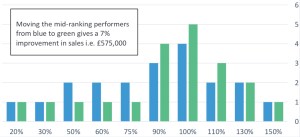
The big decision is where to focus the resources. Training often focuses on the weakest performers but usually this has limited impact on the result. Focusing on the “mighty middle” can have the most significant impact. In this example of a team of 20 salespeople each with a £500,000 target the move in the “mighty middle” generates an extra £575,000.
Make it happen
It is not enough to hear about a promising idea. Sales learning only produces a result when it is acted upon, and it only produce a sustainable result when it becomes a habit. As Heinz Goldmann (one of the initiators of consultative selling) put it “ten new ideas are good; but one new idea put into practice is even better.”
Think and feel
Much training in the past focused on knowing more than doing, thinking more than feeling, understanding more than applying.
SalesLevers enthusiastically apply Dr. Bernice McCarthy’s adult learning concept, 4MAT. This means our training moves between the linear, logical, and structured (so called “left brain” activities) and the more fluid, intuitive and creative “right brain” activities.
4MAT talks about 4 “virtual questions of learning” – why – what – how – what if?
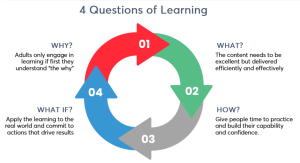
A pattern which works
SalesLevers training sessions follow a robust pattern:
- Agree why this matters to the learners and what the key issues are.
- Explore best practice and effective approaches. These should come from the learners’
experience as well as from outside expertise. - Put these ways of working to the test and build confidence in practice sessions and
simulations. - Apply into specific individual situations to create a robust action plan.
- Summarise, conclude, and move forward.
People learn in diverse ways
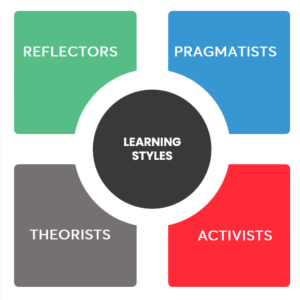
We recognise that not all people learn the same way. We build on the excellent work of Kolb and Honey & Mumford in this space.
- “Activists” want to get straight into an exercise.
- “Pragmatists” want to understand what they will get out of a session before they commit to it.
- “Theorists” need to get the detail, the back story.
- “Reflectors” need to time to observe and think before they jump in.
We like to understand people’s learning styles before we start and adapt the approach to different individuals and groups.
70/20/10
The 70/20/10 concept developed by Lombardo, Eichinger and others and championed by Charles Jennings, makes good sense for today’s business learning. It can only be a “reference model and not a formula” (Jennings) but it is a model that works.
Only 10% of business learning should come from formal sessions whether in the classroom or through virtual training. So that two-day workshop may provide vital leverage, but it is only a small part of the learning story.
A further 20% needs to come from “social learning” – coaching in the field, virtual coaching, refresher sessions in team meetings, peer-to-peer support, using playbooks and shared resources.
70% of learning comes from applying the concepts on the job, so-called “tough tasks”. This all requires two things:
- Full engagement of team leaders and middle and senior managers to ensure the learning is integrated into daily work.
- A strong tool kit with resources, reminders, and activities to turn one-off learning into embedded practice. These resources should include video shorts, play books, quick tests, summaries, and visual and digital prompts.
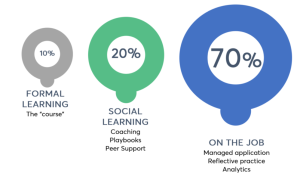
Motivation
Even at school we only really learned when we wanted to, when something or someone inspired or motivated us. The “carrot and stick” thinking of motivation icons like Herzberg, McGregor and Vroom still has its place, but it may be more useful for 21st Century learning to make use of the ideas put forward in Daniel Pink’s “Motivation 3.0” where he argues that the three most powerful internal motivators are:
Autonomy:
People want to make choices in terms of time, team, and technique. Learning needs to go with the flow on autonomy not seek to fight it with enforced rigidity.
Mastery:
If it is true, that most of us are motivated by mastering a subject then this makes learning a very satisfying and stimulating activity. We need to ask learners David Maister’s excellent question “What do you want to be famous for?” and help them achieve their goals.
Purpose:
Learning needs to have a purpose. Of course, there should be a business purpose but individuals need to see how what they are learning will help them make a difference.
Being aware of these three powerful motivations makes SalesLevers designers, coaches and deliverers engage participants and generate long lasting results.
What makes it all work?
For over 25 years the SalesLevers team has been designing and delivering learning that is consistently well-received and generated repeat business. When we look at the projects that have had a lasting impact and generated the greatest RoI, we can see that these seven components were in place.
Challenge:
What is the goal? Be clear about the objective. “Increase market share by 10% in a flat market”, “Generate 50% of revenue from our top 10% of accounts”. As Nehru said: “Failure only comes when we forget our ideals and objectives and principles.” You the client and we the provider need to agree what success will look like.
Clarify:
It is essential to have clear and accurate picture of the current situation. This means good analysis of data using the powerful tools available through SalesLevers to understand why the sales result is as it is today.
Collaborate:
SalesLevers will bring excellent training design, strong concepts, and innovative approaches to be bear but the best training comes from working together with the different stakeholders: Line management, L&D, the participants themselves.
Communicate:
Tell people in advance what to expect and why it is happening. Deliver engaging, enjoyable effective workshops. Use traditional and new techniques in the classroom and in the virtual space.
Change:
This all about changed behaviour and this needs commitment from line managers to encourage and coach-in the new practices until they become part of business as usual. It also needs effective implementation resources designed–in from the start and not retrofitted as an afterthought.
Codify:
The systems need to measure and support implementation. For example, if the KPIs do not align with changes you want to see then the impact of the learning will be limited.
Check:
Measurement is key. We still subscribe to Kirkpatrick’s four levels of measurement and will work with you to identify the response to the training, changes in understanding and thinking, changed actions, and changed results. (For more detail on measurement please see our paper “The Measurement of Sales Training.”)
An integrated approach
Sales training as a one-off, stand-alone event rarely if ever achieves its goals.
Training needs to be integrated into the various aspects of the sales organisation. SalesFitness Group takes this integrated approach from initial diagnostics through to measurement:
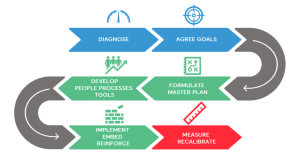
Sales Learning: Science and Art
Every week seems to bring new insights into how people learn, apply, and succeed. As we follow developments in neuroscience, we continue to adapt our ways of working, As Dr. Michael Merzenich (co-founder of Scientific Learning) puts it: “We established that the brain is modified on a substantial scale, both physically and functionally, each time we learn a new skill or develop a new ability. Our brains were created to reinvent and reconfigure themselves throughout our lifetime. This ability is known as brain plasticity.” This is extremely exciting. It means that good learning approaches can go more than skin deep and can provide significant and lasting benefits to individuals and their organisations.
Conclusions
Training does not work in a vacuum. but when it is integrated into the business then the impact can be substantial and sustainable.
SalesLevers have the experience, the tools, the resources, and the partners to make sales learning work. For case studies, a sample outline, or a conversation about how our approach might work for you then contact us at
